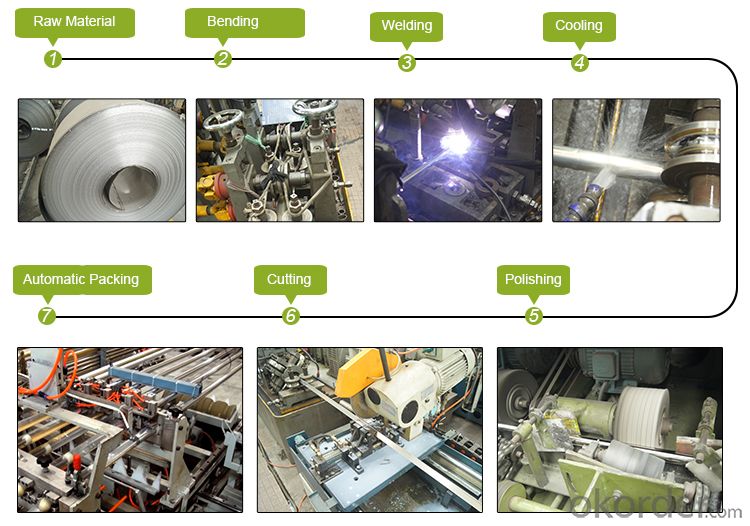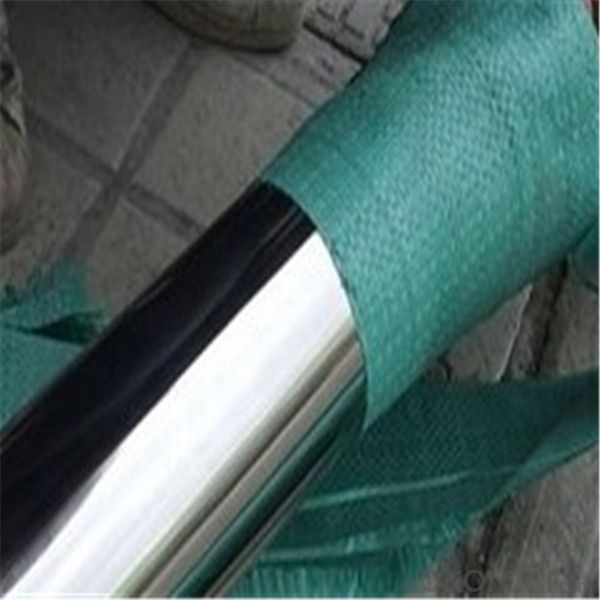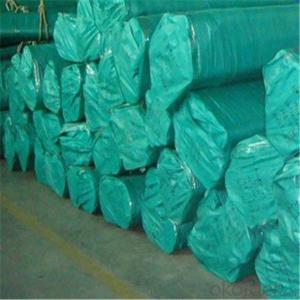304 321 316 316l Stainless Steel Seamless Pipe in Wuxi ,China
- Loading Port:
- Shanghai
- Payment Terms:
- TT OR LC
- Min Order Qty:
- 3 m.t.
- Supply Capability:
- 25000 m.t./month
OKorder Service Pledge
OKorder Financial Service
You Might Also Like
Item specifice
Product Description
C | Si | Mn | P | S | Ni | Cr | |
| SS304 | 0.046 | 0.316 | 1.481 | 0.0424 | 0.0028 | 8.001 | 18.019 |
| SS201 | 0.111 | 0.31 | 9.45 | 0.029 | 0.006 | 0.871 | 14.110 |
| SS316 | ≤0.08 | ≤1 | ≤2 | 0.035 | 0.03 | 1.0~14.0 | 16.0~18.5 |
Shape | Round / Square Etc. |
Brand | PEMCO/OEM/ODM |
Material | SS Stainless Steel 201, 304 , 316 |
Quality | First Grade |
Finish | Satin/Mirror |
Technology | Casting |
Certificate | ISO 9001-2000 |
Application | *Construction And Stair , Handrail , Railing Use |
*Shopping Mall,House,Outdoor | |
Feature | Beautiful Outlook, Easy To Clean, Low Maintenance Cost |
Usage | Widely Used On Stainless Steel Balustrade & Handrails, Indoor Or Outdoor Decorations,Etc. |
MOQ | 10 Pieces |
Delivery Time | 15-20 Days |
hot sale

Production Process


Definition of stainless steel(Adopted form Wikipedia)
In metallurgy, stainless steel, also known as inox steel or inox from French "inoxydable",
is defined as a steelalloy with a minimum of 10.5% to 11% chromium content by mass.
Stainless steel does not readily corrode, rust or stain with water as ordinary steel does,
but despite the name it is not fully stain-proof, most notably under low oxygen, high salinity,
or poor circulation environments. It is also called corrosion-resistant steel or CRES
when the alloy type and grade are not detailed, particularly in the aviation industry.
There are different grades and surface finishes of stainless steel to suit the environment
the alloy must endure. Stainless steel is used where both the properties of steel
and resistance to corrosion are required.
Surface Finish :
Surface finish | Characteristics and application |
No.2B | The surface brightness and flatness of no2B is better than no2D. then through a special surface treatment to improve its mechanical properties, No2B could nearly satisfy comprehensive uses. |
No.3 | Polished with abrasive belt of git#100-#200, have better brightness with discontinuous coarse stria, used as inner and external ornaments for building, electrical appliances and kitchen utensils etc. |
No.4 | Polished with abrasive belt of grit #150-#180,have better brightness with discontinuous coarse stria, but thinner than No3, are used as bathtub buildings inner and external ornaments electrical appliances kitchen utensils and food processing equipment etc. |
HL | Polished with abrasive belt of grit #150-#320 on the NO.4 finish and has continuous streaks, mainly used as buildings ornaments elevators, door of building, frontal plate etc. |
BA | Cold rolled, bright annealed and skin-passed, the product have excellent brightness and good reflexivity like mirror, kitchen apparatus, ornament etc. |
8K | The product have excellent brightness and prefer reflexivity can to be the mirror. |


- Q:Can stainless steel pipes be insulated with polylactide-co-glycolide?
- No, stainless steel pipes cannot be insulated with polylactide-co-glycolide as it is a biodegradable polymer commonly used in medical applications, and it may not provide sufficient insulation for pipes.
- Q:Are stainless steel pipes suitable for oil and gas applications?
- Indeed, oil and gas applications find stainless steel pipes to be appropriate. Stainless steel boasts exceptional corrosion resistance, rendering it the perfect choice for the conveyance and storage of oil and gas, substances that frequently harbor corrosive components. Additionally, stainless steel pipes exhibit remarkable strength and durability, guaranteeing their ability to endure high-pressure circumstances and unforgiving surroundings. Moreover, stainless steel proves effortless to cleanse and uphold, thus diminishing the likelihood of contamination within oil and gas operations. All in all, stainless steel pipes emerge as a dependable and economically viable option for oil and gas applications.
- Q:How do you calculate the required support spacing for stainless steel pipes?
- Several factors must be taken into account when calculating the necessary support spacing for stainless steel pipes. These factors encompass the pipe diameter, the weight of the material, the system's temperature, the fluid flowing through the pipe, and the desired safety factor. The initial step involves determining the pipe diameter. This can be achieved by direct measurement or by calculating it using the pipe's schedule and nominal size. Once the diameter is known, the weight of the stainless steel pipe per unit length can be determined using the density of stainless steel. Afterwards, the temperature of the system in which the pipe will operate must be considered. Stainless steel pipes can expand and contract with temperature changes, and this thermal expansion must be taken into account when determining support spacing. The thermal expansion coefficient of stainless steel can be utilized to calculate the expected expansion across the temperature range. The fluid flowing through the pipe should also be taken into consideration. If the fluid is corrosive or possesses high velocity or pressure, additional supports may be necessary to prevent excessive vibration or stress on the pipe. Finally, the desired safety factor must be incorporated. This factor represents the additional support spacing required to ensure the integrity and stability of the pipe system. Common safety factors typically range from 1.5 to 3, depending on the specific application and industry standards. Once all these factors are known, various industry standards and guidelines can be employed to calculate the required support spacing for stainless steel pipes. These standards provide formulas and tables that consider the aforementioned factors, enabling engineers and designers to determine the appropriate distance between pipe supports. It is important to note that qualified professionals with knowledge of industry standards and local regulations should perform these calculations to ensure the safe and efficient operation of the stainless steel pipe system.
- Q:Why does the 304 stainless steel pipe leak?
- Austenitic stainless steels are extremely sensitive to chloride ion and can occur in a very short time if the temperature and concentration are appropriate. Therefore, the relevant standards and specifications in the clear requirements for austenitic stainless steel pressure vessels for hydraulic pressure test, there are strict requirements on the chloride ion concentration of the water, and after the test to put water clean, dry. In order to avoid residual moisture in the chloride ion corrosion of stainless steel.
- Q:Can stainless steel pipes be used for semiconductor manufacturing?
- Yes, stainless steel pipes can be used for semiconductor manufacturing. Stainless steel is often chosen for its excellent corrosion resistance, high temperature resistance, and mechanical strength. These properties make stainless steel pipes suitable for various applications in the semiconductor industry, such as gas and chemical delivery systems, vacuum systems, and high-purity water distribution. Semiconductor manufacturing processes require the transportation of various gases, chemicals, and liquids, and stainless steel pipes can provide the necessary reliability and purity. The corrosion resistance of stainless steel ensures that the pipes will not contaminate the semiconductor materials or the manufacturing process. Additionally, stainless steel pipes can withstand the high temperatures involved in semiconductor manufacturing without compromising their structural integrity. Moreover, stainless steel pipes can be fabricated to meet the stringent cleanliness requirements of the semiconductor industry. They can be electropolished or passivated to remove surface impurities and contaminants, further enhancing their suitability for use in semiconductor manufacturing. Overall, stainless steel pipes offer a durable, corrosion-resistant, and high-purity solution for semiconductor manufacturing applications, making them a popular choice in the industry.
- Q:What are the different grades of stainless steel used for pipes?
- The different grades of stainless steel used for pipes include 304, 316, 321, and 347.
- Q:What are stainless steel pipes used for?
- Various industries widely use stainless steel pipes because of their exceptional durability, resistance to corrosion, and high strength. These pipes have extensive applications in plumbing systems, oil and gas industries, chemical processing plants, food and beverage processing, pharmaceutical industries, and automotive manufacturing, among others. Plumbing systems favor stainless steel pipes due to their ability to withstand high pressure and temperature, making them suitable for transporting water, gas, and other fluids. They are also commonly used in sewage and drainage systems because of their resistance to corrosion and chemical substances. In the oil and gas industries, stainless steel pipes are indispensable for transporting petroleum products, natural gas, and other fluids under high pressure and extreme temperatures. Their corrosion resistance properties make them essential in offshore and onshore drilling operations, refineries, and petrochemical plants, ensuring the safe and efficient transportation of these substances. Chemical processing plants rely on stainless steel pipes because of their resistance to chemical reactions and high temperatures. These pipes are used to transport various corrosive chemicals and gases without the risk of contamination or leakage. Additionally, they are utilized in heat exchangers, reactors, and other equipment that require corrosion-resistant materials. The food and beverage industry heavily relies on stainless steel pipes due to their hygiene and sanitary properties. These pipes are used for conveying various food products, such as milk, wine, beer, and other liquids, without altering their taste or quality. They are easy to clean, maintain, and sterilize, making them ideal for this industry. In the pharmaceutical sector, stainless steel pipes play a crucial role in conveying various drugs, chemicals, and sterile fluids. They meet the stringent requirements of the industry by ensuring product purity, preventing contamination, and offering resistance to corrosion and temperature extremes. Furthermore, stainless steel pipes are utilized in automotive manufacturing because of their structural strength and resistance to heat and corrosion. They are used in exhaust systems, fuel lines, and other components where durability and resistance to extreme conditions are necessary. In conclusion, stainless steel pipes are versatile and essential in numerous industries, providing the perfect combination of strength, durability, and corrosion resistance required for a wide range of applications.
- Q:How do stainless steel pipes compare to PEX pipes?
- Stainless steel pipes and PEX pipes have different characteristics and applications. Stainless steel pipes are known for their strength, durability, and resistance to corrosion, making them ideal for high-pressure and high-temperature applications. They are commonly used in industrial settings and for water supply systems. On the other hand, PEX pipes are flexible, lightweight, and easy to install, making them suitable for residential plumbing systems. PEX pipes have good resistance to freezing and are less prone to leaks compared to other materials. Ultimately, the choice between stainless steel and PEX pipes depends on the specific needs and requirements of the project.
- Q:How do you calculate the pipe length required for a specific application?
- To calculate the pipe length required for a specific application, there are several factors that need to be considered. 1. Flow Rate: Determine the desired flow rate or the amount of fluid to be transported through the pipe per unit of time. This can be measured in gallons per minute (GPM), liters per second (L/s), or any other appropriate unit. 2. Pipe Material: Identify the material of the pipe that will be used for the application. Different materials have different friction coefficients, which will affect the overall length required. 3. Friction Loss: Calculate the friction loss in the pipe based on the flow rate and the material properties. This involves determining the friction factor for the specific pipe material and using the appropriate equation (such as Darcy-Weisbach equation or Hazen-Williams equation) to calculate the friction loss. 4. Pressure Drop: Consider the desired pressure drop across the pipe. This is typically specified by the application requirements or system design. The pressure drop can be calculated using the Bernoulli's equation or other relevant equations. 5. Pipe Diameter: Determine the appropriate pipe diameter based on the desired flow rate and the allowable pressure drop. This can be done by using pipe sizing charts or equations specific to the pipe material and the flow characteristics. 6. Pipe Length Calculation: Once the pipe diameter is known, calculate the length required based on the desired flow rate, pressure drop, and the friction loss. This can be done using various pipe sizing equations or software tools available for the specific pipe material. 7. Additional Factors: Consider any additional factors that may affect the pipe length calculation, such as elevation changes, fittings, valves, or other components in the system. These factors may introduce additional friction losses or pressure drops that need to be accounted for. It is important to note that pipe length calculations are typically performed by engineers or professionals with expertise in fluid mechanics and pipe system design. Consulting relevant codes, standards, and guidelines specific to the application is also recommended to ensure compliance with safety and performance requirements.
- Q:Can stainless steel pipes be used for geothermal applications?
- Yes, stainless steel pipes can be used for geothermal applications. Stainless steel is a durable and corrosion-resistant material that can withstand the harsh conditions and high temperatures associated with geothermal systems. It is particularly suitable for geothermal applications due to its resistance to corrosion caused by the presence of minerals and chemicals in the geothermal fluid. Stainless steel pipes also have excellent heat transfer properties, which is essential for efficient heat exchange in geothermal systems. Additionally, stainless steel pipes have a long lifespan and require minimal maintenance, making them a reliable choice for geothermal applications.
1. Manufacturer Overview |
|
|---|---|
| Location | |
| Year Established | |
| Annual Output Value | |
| Main Markets | |
| Company Certifications | |
2. Manufacturer Certificates |
|
|---|---|
| a) Certification Name | |
| Range | |
| Reference | |
| Validity Period | |
3. Manufacturer Capability |
|
|---|---|
| a)Trade Capacity | |
| Nearest Port | |
| Export Percentage | |
| No.of Employees in Trade Department | |
| Language Spoken: | |
| b)Factory Information | |
| Factory Size: | |
| No. of Production Lines | |
| Contract Manufacturing | |
| Product Price Range | |
Send your message to us
304 321 316 316l Stainless Steel Seamless Pipe in Wuxi ,China
- Loading Port:
- Shanghai
- Payment Terms:
- TT OR LC
- Min Order Qty:
- 3 m.t.
- Supply Capability:
- 25000 m.t./month
OKorder Service Pledge
OKorder Financial Service
Similar products
New products
Hot products
Related keywords



























